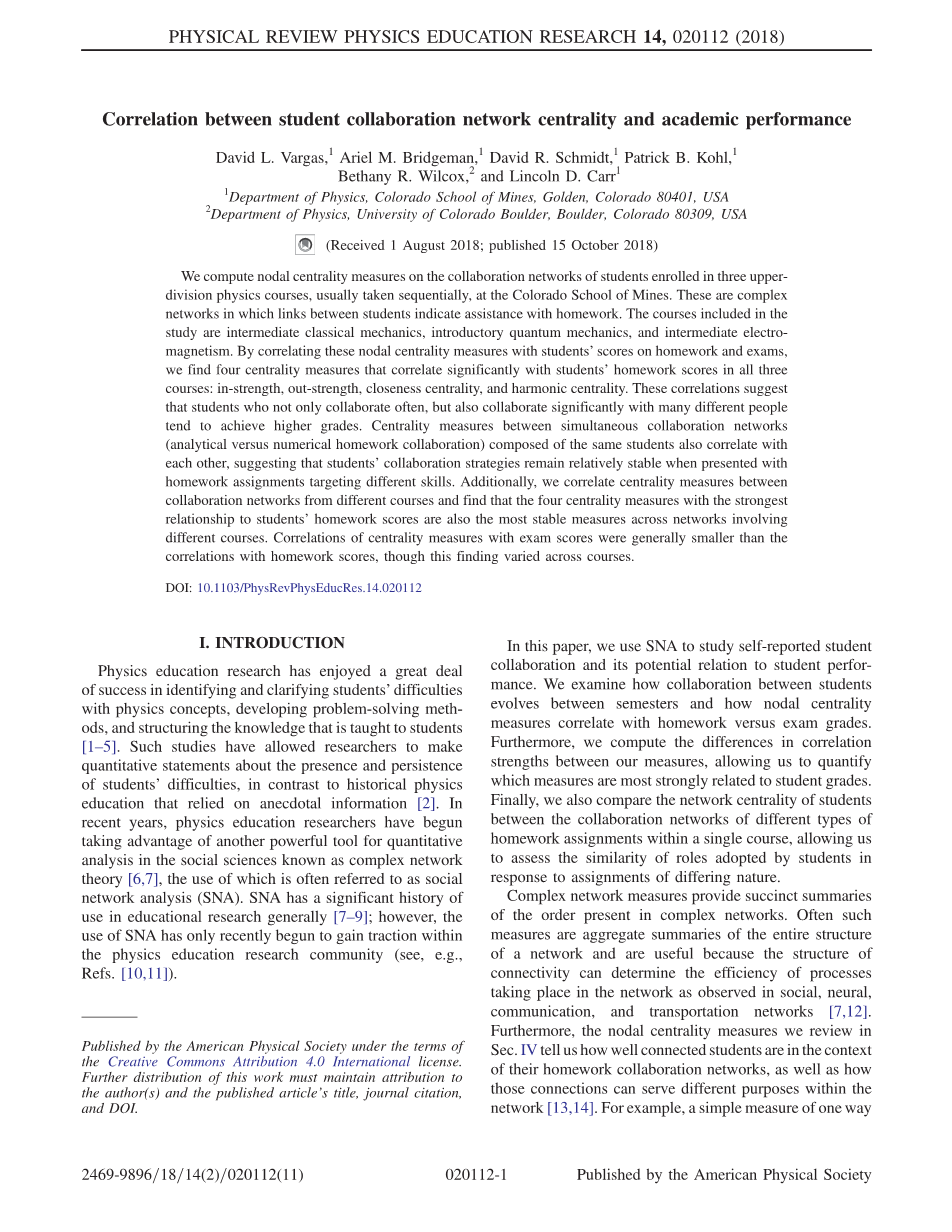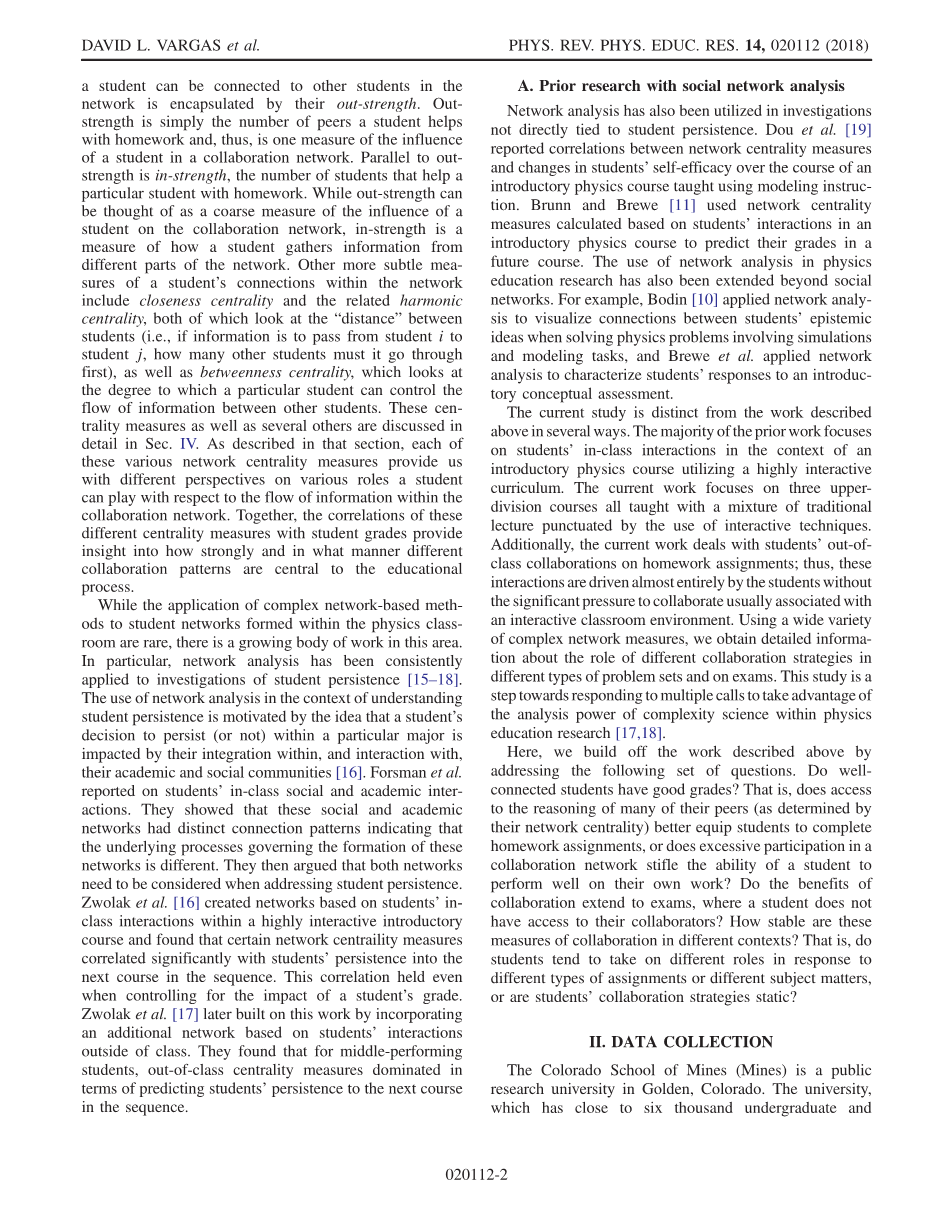微课在初中科学教学中的应用研究外文翻译资料
2022-12-29 11:42:10
本科毕业设计(论文)
外文翻译
Correlation between student collaboration network centrality and academic performance
作者:David L. Vargas, Ariel M. Bridgeman, David R. Schmidt, Patrick B. Kohl, Bethany R. Wilcox, and Lincoln D. Carr
国籍:American
出处:PHYSICAL REVIEW PHYSICS EDUCATION RESEARCH
原文正文:
We compute nodal centrality measures on the collaboration networks of students enrolled in three upper-division physics courses, usually taken sequentially, at the Colorado School of Mines. These are complex networks in which links between students indicate assistance with homework. The courses included in the study are intermediate classical mechanics, introductory quantum mechanics, and intermediate electromagnetism. By correlating these nodal centrality measures with studentsrsquo; scores on homework and exams, we find four centrality measures that correlate significantly with studentsrsquo; homework scores in all three courses: in-strength, out-strength, closeness centrality, and harmonic centrality. These correlations suggest that students who not only collaborate often, but also collaborate significantly with many different people tend to achieve higher grades. Centrality measures between simultaneous collaboration networks (analytical versus numerical homework collaboration) composed of the same students also correlate with each other, suggesting that studentsrsquo; collaboration strategies remain relatively stable when presented with homework assignments targeting different skills. Additionally, we correlate centrality measures between collaboration networks from different courses and find that the four centrality measures with the strongest relationship to studentsrsquo; homework scores are also the most stable measures across networks involving different courses. Correlations of centrality measures with exam scores were generally smaller than the correlations with homework scores, though this finding varied across courses.
I. INTRODUCTION
Physics education research has enjoyed a great deal of success in identifying and clarifying studentsrsquo; difficulties with physics concepts, developing problem-solving methods, and structuring the knowledge that is taught to students. Such studies have allowed researchers to make
quantitative statements about the presence and persistence of studentsrsquo; difficulties, in contrast to historical physics education that relied on anecdotal information. In recent years, physics education researchers have begun taking advantage of another powerful tool for quantitative analysis in the social sciences known as complex network theory, the use of which is often referred to as social network analysis (SNA). SNA has a significant history of use in educational research generally; however, the use of SNA has only recently begun to gain traction within the physics education research community.
In this paper, we use SNA to study self-reported student collaboration and its potential relation to student performance. We examine how collaboration between students evolves between semesters and how nodal centrality measures correlate with homework versus exam grades. Furthermore, we compute the differences in correlation strengths between our measures, allowing us to quantify which measures are most strongly related to student grades. Finally, we also compare the network centrality of students between the collaboration networks of different types of homework assignments within a single course, allowing us to assess the similarity of roles adopted by students in response to assignments of differing nature.
Complex network measures provide succinct summaries of the order present in complex networks. Often such measures are aggregate summaries of the entire structure of a network and are useful because the structure of connectivity can determine the efficiency of processes taking place in the network as observed in social, neural, communication, and transportation networks. Furthermore, the nodal centrality measures we review in Sec. IV tell us howwell connected students are in the context of their homework collaboration networks, as well as how those connections can serve different purposes within the network. For example, a simple measure of one way a student can be connected to other students in the network is encapsulated by their out-strength. Outstrength is simply the number of peers a student helps with homework and, thus, is one measure of the influence of a student in a collaboration network. Parallel to outstrength is in-strength, the number of students that help a particular student with homework. While out-strength can be thought of as a coarse measure of the influence of a student on the collaboration network, in-strength is a measure of how a student gathers information from different parts of the network. Other more subtle measures of a studentrsquo;s connections within the network include closeness centrality and the related harmonic centrality, both of which look at the “distance” between students (i.e., if information is to pass from student i to student j, how many other students must it go through first), as well as betweenness centrality, which looks at the degree to which a particular student can control the flow of information between other students. These centrality measures as well as several others are discussed in detail in Sec. IV. As described in that section, each of these various network centrality measures provide us with different perspectives on various roles a student can play with respect to the flow of information within the collaboration network. Together, the correlations of these different centrali
剩余内容已隐藏,支付完成后下载完整资料


英语原文共 11 页,剩余内容已隐藏,支付完成后下载完整资料
资料编号:[276544],资料为PDF文档或Word文档,PDF文档可免费转换为Word




